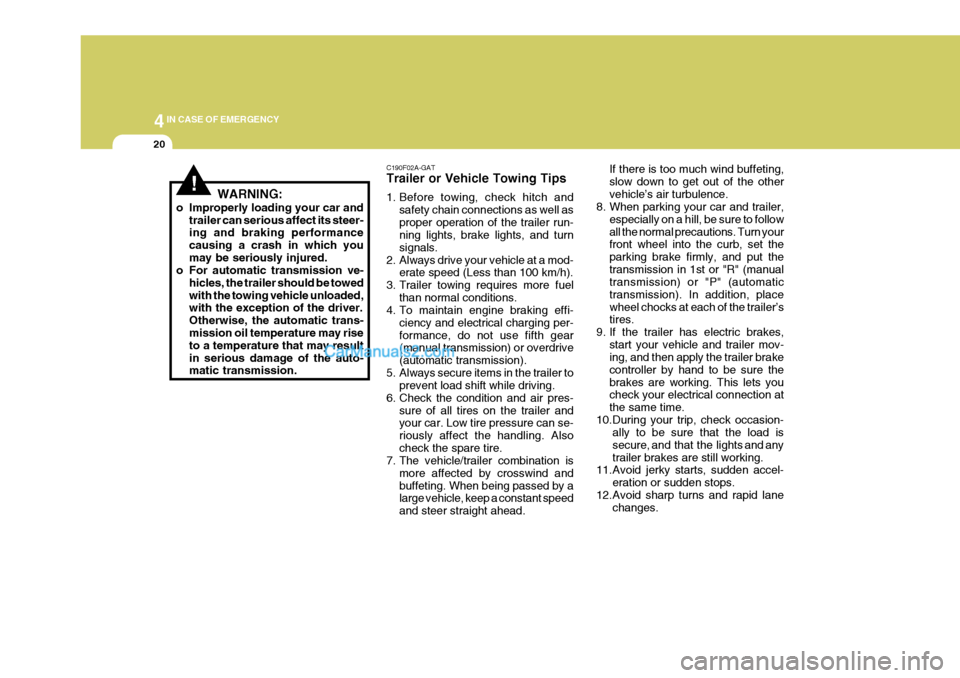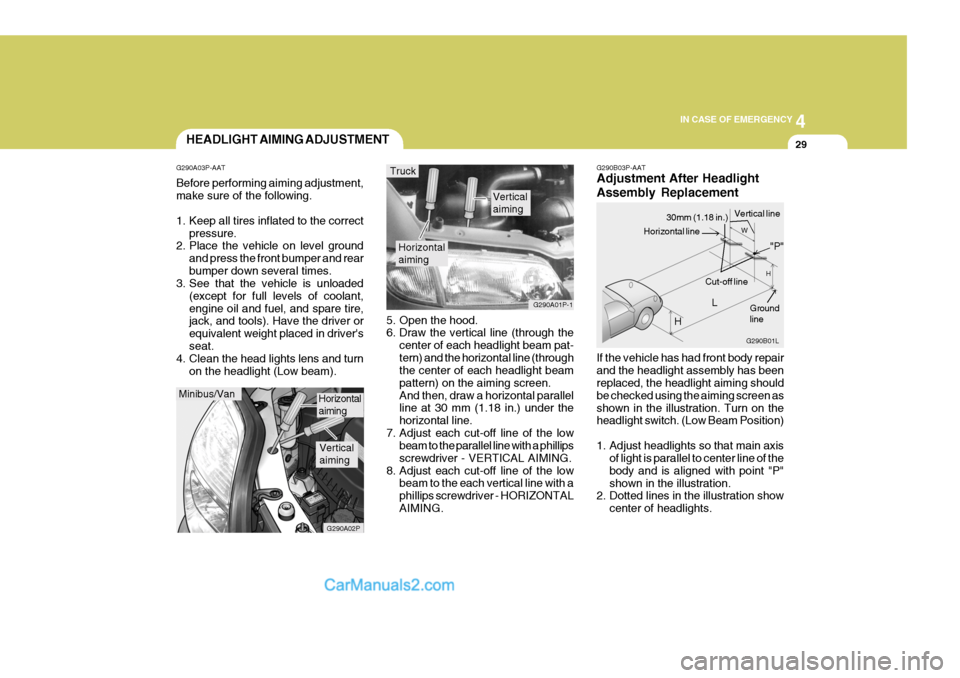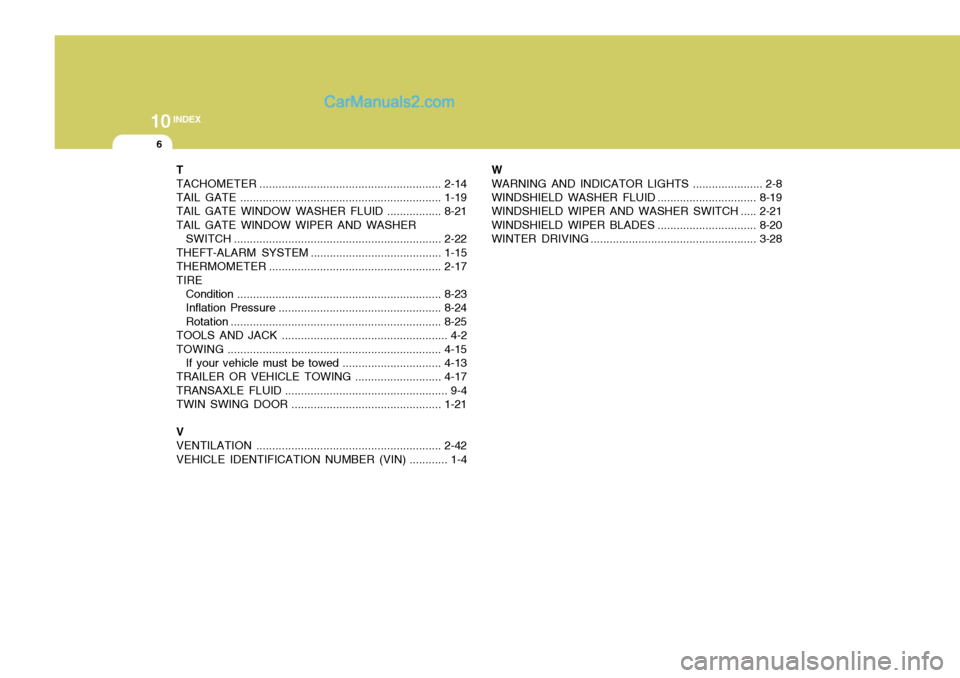2005 Hyundai H-1 (Grand Starex) lights
[x] Cancel search: lightsPage 121 of 205

44IN CASE OF EMERGENCY
20
!WARNING:
o Improperly loading your car and trailer can serious affect its steer- ing and braking performance causing a crash in which youmay be seriously injured.
o For automatic transmission ve-
hicles, the trailer should be towedwith the towing vehicle unloaded, with the exception of the driver. Otherwise, the automatic trans-mission oil temperature may rise to a temperature that may result in serious damage of the auto- matic transmission. C190F02A-GAT Trailer or Vehicle Towing Tips
1. Before towing, check hitch and
safety chain connections as well as proper operation of the trailer run- ning lights, brake lights, and turn signals.
2. Always drive your vehicle at a mod- erate speed (Less than 100 km/h).
3. Trailer towing requires more fuel than normal conditions.
4. To maintain engine braking effi-
ciency and electrical charging per-formance, do not use fifth gear (manual transmission) or overdrive (automatic transmission).
5. Always secure items in the trailer to prevent load shift while driving.
6. Check the condition and air pres- sure of all tires on the trailer and your car. Low tire pressure can se- riously affect the handling. Alsocheck the spare tire.
7. The vehicle/trailer combination is
more affected by crosswind andbuffeting. When being passed by a large vehicle, keep a constant speed and steer straight ahead. If there is too much wind buffeting,slow down to get out of the othervehicle’s air turbulence.
8. When parking your car and trailer,
especially on a hill, be sure to followall the normal precautions. Turn your front wheel into the curb, set the parking brake firmly, and put thetransmission in 1st or "R" (manual transmission) or "P" (automatic transmission). In addition, placewheel chocks at each of the trailer’s tires.
9. If the trailer has electric brakes, start your vehicle and trailer mov-ing, and then apply the trailer brake controller by hand to be sure thebrakes are working. This lets you check your electrical connection at the same time.
10.During your trip, check occasion- ally to be sure that the load issecure, and that the lights and anytrailer brakes are still working.
11.Avoid jerky starts, sudden accel-
eration or sudden stops.
12.Avoid sharp turns and rapid lane changes.
Page 128 of 205

4
CORROSION PREVENTION AND APPEARANCE CARE
27
4
IN CASE OF EMERGENCY
27
CAUTION:
When replacing a fusible link, never use anything but a new fusible link with the same or lower amperagerating. Never use a piece of wire or a higher-rated fusible link. This could result in serious damage andcreate a fire hazard.! G200B02A-AAT Replacing Accessory Fuse The fuse box for the lights and other electrical accessories will be found lowon the dashboard on the driver's side. Inside the box you will find a list show- ing the circuits protected by each fuse.If any of your car's lights or other electrical accessories stop working, a blown fuse could be the reason. If thefuse has burned out, you will see that the metal strip inside the fuse has burned through.HSR4021
CHECKING AND REPLACING FUSES
G200A01A-AAT Replacing a Fusible Link
HSRFL200
Melted
Good
A fusible link will melt if the electrical circuits from the battery are ever over-loaded, thus preventing damage to the entire wiring harness. (This could be caused by a short in the system draw-ing too much current.) If this ever happens, have a Hyundai dealer de- termine the cause, repair the systemand replace the fusible link. The fusible links are located in a fuse box for easy inspection.
Page 130 of 205

4
CORROSION PREVENTION AND APPEARANCE CARE
29
4
IN CASE OF EMERGENCY
29
G290B03P-AAT Adjustment After Headlight Assembly Replacement If the vehicle has had front body repair and the headlight assembly has been replaced, the headlight aiming should be checked using the aiming screen asshown in the illustration. Turn on the headlight switch. (Low Beam Position)
1. Adjust headlights so that main axis
of light is parallel to center line of the body and is aligned with point "P"shown in the illustration.
2. Dotted lines in the illustration show
center of headlights.
5. Open the hood.
6. Draw the vertical line (through the
center of each headlight beam pat- tern) and the horizontal line (through the center of each headlight beam pattern) on the aiming screen.And then, draw a horizontal parallel line at 30 mm (1.18 in.) under the horizontal line.
7. Adjust each cut-off line of the low beam to the parallel line with a phillipsscrewdriver - VERTICAL AIMING.
8. Adjust each cut-off line of the low beam to the each vertical line with aphillips screwdriver - HORIZONTALAIMING.
Horizontal aiming
Verticalaiming
G290A01P-1
Truck
G290B01L
LW
H
H Cut-off line
Ground line
"P"
Horizontal line
30mm (1.18 in.) Vertical line
HEADLIGHT AIMING ADJUSTMENT
G290A03P-AAT Before performing aiming adjustment, make sure of the following.
1. Keep all tires inflated to the correct pressure.
2. Place the vehicle on level ground
and press the front bumper and rear bumper down several times.
3. See that the vehicle is unloaded
(except for full levels of coolant,engine oil and fuel, and spare tire, jack, and tools). Have the driver or equivalent weight placed in driver'sseat.
4. Clean the head lights lens and turn
on the headlight (Low beam).
Minibus/Van
G290A02P
Horizontal aiming
Verticalaiming
Page 131 of 205

44IN CASE OF EMERGENCY
30
Specifications: "H": Horizontal center line of headlights from ground "W":Distance between each headlight cen-ter "L": Distance between the headlights and the wall that the lights are tested against : 3,000 mm (118.11 in.).
2WD 4WD
Long wheel base
Extra long
wheel base
MINIBUS 894
(35.20) 1006
(39.61)
- - VAN
855
(33.66)
--- TRUCK
--
847
(33.35) 845
(33.27)2WD 4WD
Long wheel base
Extra long
wheel base
MINIBUS
- - VAN
-- TRUCK
--
1272
(50.08)
1380
(54.33)
REPLACEMENT OF LIGHT BULBS
G260A02A-AAT Before attempting to replace a head- light bulb, be sure the switch is turned to the "OFF" position. The next paragraph shows how toreach the headlight bulbs so they may be changed. Be sure to replace the burned-out bulb with one of the samenumber and wattage rating. See page 4-35 for the wattage descrip- tions.
CAUTION:
Keep the lamps out of contact withpetroleum products, such as oil,gasoline, etc.
!
mm(in.)
mm(in.)
Page 186 of 205

8
DO-IT YOURSELF MAINTENANCE
17
!
On a vehicle with the brake fluid
warning lamp, the brake fluid level is monitored by a float. When the brake fluid level falls to below the "MIN" mark, the brake fluid warning lamplights up.
WARNING:
o Use only the specified brake fluid. Also, the additives in dif-ferent brands may result in a chemical reaction when mixed together, so avoid mixing differ-ent brands if possible.
o Use extreme caution in filling
the brake fluid because it is toxicand corrosive, and it can harm your eyes and damage painted surface. If the fluid gets in youreyes, flush your eyes with clean water.
CHECKING THE AUTOMATIC TRANSMISSION FLUID
I120A02P-GAT (If installed) Transmission fluid in the automatic transmission should be changed at those intervals specified in the ve- hicle maintenance schedule in Sec-tion 6. NOTE: Automatic transmission fluid is a red color. As driving distance in- creases, the fluid color turns dark-ish red gradually. It is a normal condition and you should not judge the need to replace basedupon the changing color.You must replace the automatictransmission fluid in accordance with intervals specified in the ve- hicle maintenance schedule in sec-tion 6.CHECKING THE CLUTCH FLUID
I110A01P-GAT (If installed) In the case of vehicles with the hy- draulic operating clutch, the reservoir for the clutch fluid also serves as the reservoir for the brake fluid. See theparagraph on the brake fluid.
Page 203 of 205

10INDEX
4
I IF THE ENGINE OVERHEATS ................................ 4-25
IF THE ENGINE WILL NOT START .......................4-23
IF YOU HAVE A FLAT TIRE ..................................... 4-6
IGNITION SWITCH .................................................... 3-3
ILLUMINATED IGNITION SWITCH .........................1-11
IMMOBILIZER SYSTEM ............................................ 1-6
INCLI NOMETER ....................................................... 2-17
INSTALLATION OF ACCESSORIES ......................... 1-4
INSTRUMENT CLUSTER AND
INDICATOR LIGHTS ............................................... 2-2
INSTRUMENTS PANEL LIGHT CONTROL (RHEOSTAT) ......................................................... 2-24
INTERIOR LIGHT ..................................................... 2-28
J
JACK ........................................................................... 4-2JUMP STARTING ..................................................... 4-24
K
KEYS ........................................................................... 1-6 KEY POSITI ONS ........................................................ 3-3
L
LOADING .................................................................. 3-22
LOCKING DIFFERENTIAL ....... ................................3-31
LUBRICATION CHART .............................................. 9-4 MMAINTENANCE INTERVALS
..................................... 6-2
MAKING A FLAT SEAT .... .......................................1-36
MANUAL TRANSMISSION .................. ...................... 3-7
MEASUREMENT ........................................................ 9-2MULTI-FUNCTION LIGHT SWITCH Daytime Running Lights .................... ..................... 2-20
Headlight Flasher ................................................... 2-20
Headlight Switch .................................................... 2-19
High-beam Switch .................................................. 2-20
Lane Change Si gnal .............................................. 2-19
Parking Light Auto Cut .................. ........................ 2-20
Turn Signal Switch................................................. 2-19
MULTIMETER Altimeter ................................................................. 2-18
Inclinometer ............................................................ 2-17
Thermometer .......................................................... 2-17
OODOMETER/TRIP ODOMETER ..............................2-14
OPERATING THE SUNROOF SYSTEM .................2-31
OUTSIDE REARVIEW MIRROR ..............................2-34
OUTSIDE REARVIEW MIRROR HEATER ..............2-35
OVERDRIVE SWITCH ............................................. 3-12
OVERHEAD AIR COND ITIONING........................... 2-47
Page 205 of 205

10INDEX
6
T TACHOMETER ......................................................... 2-14
TAIL GATE ............................................................... 1-19
TAIL GATE WINDOW WASHER FLUID .................8-21
TAIL GATE WINDOW WIPER AND WASHER SWITCH ................................................................. 2-22
THEFT-ALARM SYSTEM .............. ........................... 1-15
THERMOMETER ...................................................... 2-17
TIRE Condition ................................................................ 8-23
Inflation Pressure ................................................... 8-24
Rotation .................................................................. 8-25
TOOLS AND JACK .................................................... 4-2
TOWING ................................................................... 4-15
If your vehicle must be towed ...............................4-13
TRAILER OR VEHICLE TOWING........................... 4-17
TRANSAXLE FLU ID ................................................... 9-4
TWIN SWING DOOR ............................................... 1-21
V VENTILATION .......................................................... 2-42
VEHICLE IDENTIFICATION NUMBER (VIN) ............ 1-4W WARNING AND INDICATOR
LIGHTS ...................... 2-8
WINDSHIELD WASHER FLUID ...............................8-19
WINDSHIELD WIPER AND WASHER SWITCH ..... 2-21
WINDSHIELD WIPER BLADES ...............................8-20
WINTER DRIVING .................................................... 3-28